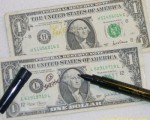As I was waiting to checkout, the person running the cash register was having difficulties with someone whose credit card was not being accepted. It did not matter what the problem was, the issue was holding up the line. While waiting, the gentleman next on line turned to me and said, “This is why I pay in cash.”
Apparently, my fellow line waiter and I had one thing in common, we both visited the bank prior to doing our shopping. He paid for his purchase with crisp, new currency. Just like my new currency, they were mostly $20 Federal Reserve Notes in serial number order fresh from a pack that was opened in the bank.
When the cashier counted the money, she picked up a pen and drew a line on each note. The pen was a counterfeit detection pen that contains an iodine-based ink used to determine whether the paper used is counterfeit.
These iodine pens test whether the paper is legitimate by checking if the iodine reacts with the starch that is used in commercial paper to make them look brighter. If the paper contains starch, then the ink turns dark indicating the paper is not real currency paper. Otherwise, the mark stays amber on the normal cotton bond paper.
There are two problems with this method of counterfeit detection. First, it is relatively easy to defeat the iodine pen by washing and bleaching a low denomination bill and reprinting a higher denomination on the same paper. By using legitimate currency paper, testing it with the iodine pen will not detect that it is counterfeit.
I remember there was a story on one of the television networks about how counterfeiters bleached $5 notes and passed them off as $20 notes after reprinting them. While searching, I found the following video of NBC’s Chris Hanson as he reported about this on Dateline:
Another problem with using iodine pens is that merchants that use them put their customers in danger who have iodine allergies. Those of us with severe iodine allergies can experience anaphylaxis, a serious reaction whose rapid onset can be so severe that it can cause death. As one of those people with severe iodine allergies, I watched this scene in horror.
Following a discussion with the manager, I consented to using a credit card since this was not one of those retailers that have been in the news for being hacked.
After all the Bureau of Engraving and Printing does to ensure that the new currency is more difficult to counterfeit and how the criminals are getting around these iodine pens by using real currency paper, it is incredible to think that these stores are still using tried but untrue measures for counterfeit detection.
In the meantime, the more serious counterfeiters are bleaching and overprinting $5 notes because as the criminal in the video says, nobody looks!



I have been busy and not well so this is as soon as I could reply. I work for a major retailer. Years ago, a few weeks before the ANA had its Worlds Fair of Money in Boston, I was working in the back of the store with an Assistant Store Manager on a project. A woman from Customer Service came running in with $100 bills in her hand. She said a customer wanted a money order for $2000 and pay for them with $100 bills that she insisted did not feel real.
The Assistant Manager knew that I collect US paper money so he asks me for help. It was a bright sunny July day. We had a garage door on one of the loading docks open so I took one of the $100s there and held it up to the sunlight. It had security threads and a watermark. I told that to the Assistant Manager.
The woman from customer service insisted it did not feel real, so I said to call the police. Let them handle it. She had made an excuse to the customer.
We did not have to call the police. They came to us. The police came and said that two other stores in the area had been hit with counterfeit money and were wondering if they had been at our store. Two men were quickly arrested. I found the penalty for counterfeiting on the US Secret Service’s website after I came home. It is up to 15 years in prison and a fine.
Weeks later, in August, I was at the ANA World’s Fair of Money. I told the story to a BEP Representative. He said that some counterfeit these days is so good that the difference can only be told by feel.